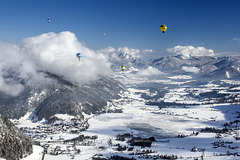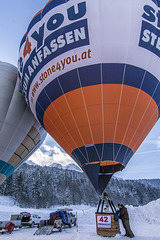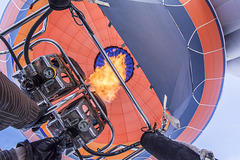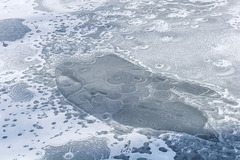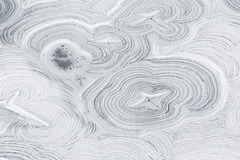
Up and Away
* Ascension *
| |
|
|
|
Ballooning across the lake 'Walchsee', which is situated between the 'Kaiser Mountains' (right-hand) and the 'Chiemgau Alps' (left-hand). Viewe from west to east. Left-hand in the foreground the village Walchsee . In the middle of the background, below the yellow-green balloon, the village of Kössen .
Have a nice Boxing Day!
~~~~~
Ballonfahrt über den Walchsee, der zwischen dem Kaisergebirge (rechts) und den Chiemgauer Alpen (links) liegt. Blick von Westen nach Osten. Im Vordergrund links unten die Gemeinde Walchsee . In der Bildmitte hinten - unter dem grüngelben Ballon - die Gemeinde Kössen .
Einen wunderschönen 2. Weihnachtstag wünsch ich euch!
~~~~~
Kaiserwinkl Ballooning near Walchsee (Tyrol, Austria), January 2016.
Closer to the lake:
Scheduling
| |
|
|
|
Swelling the balloon. I'm always amazed, that nothing else burns but the gas.
~~~~~
"Aufblasen" der Ballonhülle. Wobei ich immer wieder erstaunt bin, dass dabei nichts abfackelt.
~~~~~
Kaiserwinkl Ballooning near Walchsee (Tyrol, Austria), January 2016.
Head-to-Head
| |
|
|
The two pilots, which took my wife and me to a wonderful photographic journey through the air.
~~~~~
Die beiden Piloten, die meine Frau und mich zu einer wunderbaren Fototour durch die Lüfte mitgenommen haben.
~~~~~
Kaiserwinkl Ballooning near Walchsee (Tyrol, Austria), January 2016.
Starting the balloon:
Hot Air
| |
|
|
|
Hot air is the mystery, which helps human beeings to lift-off of the ground since more than 230 years.
(Before somebody asks: The structure in the upper right corner of the picture belongs to the neighbouring ballon. Very close by.)
~~~~~
Heiße Luft ist das Mysterium, welches den Menschen seit über 230 Jahren erlaubt, sich vom Erdboden in die Lüfte zu erheben.
(Bevor Fragen gestellt werden: Rechts oben im Bild sieht man die Hülle des Nachbarballons, der zeitgleich startet. Dicht an dicht!)
~~~~~
Kaiserwinkl Ballooning near Walchsee (Tyrol, Austria), January 2016.
The balloon in total:
Up and Away
| |
|
|
|
A little bit later.
~~~~~
Kurz nach dem Start.
~~~~~
Kaiserwinkl Ballooning near Walchsee (Tyrol, Austria), January 2016.
Alongside the Road
| |
|
|
|
Launch sites are not easily to be found in wintertime.
~~~~~
Startplätze sind rar im Winter.
~~~~~
Aerial photo while ballooning near Walchsee (Tyrol, Austria), January 2016.
View across the whole valley:
The blower:
Continuing . . .
In File
| |
|
|
In Reih und Glied - bereit zum Start.
~~~~~
Aerial photo while ballooning near Walchsee (Tyrol, Austria), January 2016.
At Eye Level
Dancing With Clouds
| |
|
|
|
Aerial capture out of a hot-air balloon crossing the lake 'Walchsee' (Tyrol, Austria).
Luftaufnahme aus einem Heißluftballon über dem Walchsee (Tirol, Österreich).
~~~~~
Aerial photo while ballooning near Walchsee (Tyrol, Austria), January 2016.
Lake WALCHSEE
| |
|
|
|
Seldom to be seen from that angel of view. Even more seldom with such a lack of snow on the surface of the frozen lake, because in last winter we had only few snowfalls in Tyrol until end of January.
(Aerial capture out of a hot-air balloon crossing the lake 'Walchsee' (Tyrol, Austria).)
~~~~~
Selten zu sehen aus dieser Perspektive - und noch seltener mit so wenig Schnee auf dem Eis. Denn es hatte im vergangenen Winter bis Ende Januar extrem wenig geschneit.
(Luftaufnahme aus einem Heißluftballon über dem Walchsee (Tirol, Österreich).)
~~~~~
Aerial photo while ballooning near Walchsee (Tyrol, Austria), January 2016.
From a greater distance:
Disclosing the secrets of the structures:
Patterns of Nature
| |
|
|
|
I never saw those structures before.
The reason is exciting:
1. some background: The lake 'Walchsee' is of natural origin with a depth of approximately 21 meters. Two thirds of his waters come from forests and from nature, one third comes from agricultural land. Therefore the water has a hight concentration of organic particles (no chlorellas, but died off plant materials). The visibility is only 3,5 meters on average. In summertime the temperature of water rises up until 23 degrees centigrade. Therefore this lake is very popular for swimming.
de.wikipedia.org/wiki/Walchsee_%28See%29
~~~~~
Ich hab nie zuvor solche Eisstrukturen gesehen.
Die Erklärung ist erstaunlich:
1. muss man dazu wissen: Der Walchsee ist ein bis zu 21m tiefer Trogsee natürlichen Ursprungs. Zwei Drittel seines Wassers stammt aus Wäldern und der Natur, ein Drittel von landwirtschaftlich genutzten Flächen. Das Wasser hat deshalb eine hohe Konzentration an organischen Partikeln (keine Algen, sondern abgestorbenes Pflanzenmaterial). Die mittlere Sicht beträgt nur 3,5 m. Im Sommer erreicht der See dadurch eine Wassertemperatur von 23 Grad, was ihn zu einem beliebten Badesee macht.
de.wikipedia.org/wiki/Walchsee_%28See%29
~~~~~
Aerial photo while ballooning near Walchsee (Tyrol, Austria), January 2016.
Disclosing the secret, part 2:
Amazing Structures
| |
|
|
|
I never saw those structures before.
The reason is exciting.
2. This phenomenon is known from elsewhere: The phenomenon of ice circles has bee described in 1882. But it didn't evoke interest of scientists before 1995, when very large ice circles were seen on satellite photographs of lake Baikal with diameters of some kilometers. As recently as 2009 those ice circles were explored. Measurements of temperature and flow underneath the frozen surface uncovered the mystery.
Beneath the ice circles large vortices are stirring. Those circulating waters cause the dark ringlike structures. The vortices originate from ascending methane bubbles, which are developping by decomposing of organic materials at the bottom of the lake. The bubbles take warm waters on their way up. A vertical flow results, which is circling under the influence of the Coriolis force - in the same manner as waters do within the plug hole of an wash-bowl, but reverse.
www.spiegel.de/wissenschaft/natur/a-674932.html
If you know, what you have to be looking for, you'll find some more interesting pictures within the worldwide web:
www.leidorf.de/images/dzoom/grafik/1Ds38720_Eis.jpg
~~~~~
Ich hab nie zuvor solche Eisstrukturen gesehen.
Die Erklärung ist erstaunlich:
2. ist das Phänomen von anderswo bekannt: Das Phänomen der Eiskreise wurde schon 1882 beschrieben, erweckte aber erst 1995 wissenschaftliches Interesse, weil auf Satellitenaufnahmen kilometergroße Eiskreise auf dem Baikalsee entdeckt wurden. Erst 2009 wurden diese Eiskreise genauer erforscht. Temperatur- und Strömungsmessungen unter der Eisoberfläche brachten die Erklärung.
Unter den Eiskreisen bewegen sich Strudel. Das kreisförmig zirkulierende Wasser verursacht die dunklen Ringstrukturen im Eis. Ursache für die Strudel ist aufsteigendes Methangas aus sich zersetzendem Pflanzenmaterial am Boden des Sees. Die Gasblasen nehmen wärmeres Wasser mit hoch. Es entsteht eine Aufwärtsströmung, die sich unter dem Einfluss der Corioliskraft zu drehen beginnt - wie das Wasser im Abfluss eines jeden Waschbeckens, nur umgekehrt herum.
www.spiegel.de/wissenschaft/natur/a-674932.html
Wenn man weiß, wonach man suchen soll, findet man übrigens weitere interessante Aufnahmen:
www.leidorf.de/images/dzoom/grafik/1Ds38720_Eis.jpg
~~~~~
Aerial photo while ballooning near Walchsee (Tyrol, Austria), January 2016.
Disclosing the secret, part 1:
Disclosing the secret, part 3:
Ice Circles
| |
|
|
|
I never saw those structures before.
The reason is exciting:
3. With regard to the lake Walchsee it means: The water of this lake is heavily contaminated with dead organic particles, which are washed in by the tributary waters. As time goes by they sink to the bottom of the lake, forming a layer of dead organic material there. Step by step this material decomposites and forms marsh gas. (This phenomenon is well known. You may watch it at lakes or pools in forests.) The gas rises in bubbles. But within the Walchsee they only have 21 meters of altitude to ascend. Therefore they stay less than bubbles within the lake Baikal, which has a depth of 1.600 meterns. That's the reason why the ice circles on the Walchsee are smaller.
~~~~~
Ich hab nie zuvor solche Eisstrukturen gesehen.
Die Erklärung ist erstaunlich:
3. übertragen auf den Walchsee bedeutet das: Das Wasser des Walchsees ist stark mit toten organischen Partikeln belastet, welche durch die Zuflüsse eingetragen werden und im See allmählich auf den Grund sinken. Dort bildet sich eine Schicht aus totem organischen Material, dass sich allmählich zersetzt. (Dieses Phänomen ist bekannt und weit verbreitet. Man kann es in vielen kleinen Waldtümpeln beobachten.) Dabei entsteht sog. Sumpfgas, das in Blasen aufsteigt. Die Gasblasen haben im Walchsee allerdings nur bis zu 21m Aufstiegshöhe. Deshalb bleiben sie kleiner als im Baikalsee mit seinen 1.600 Metern Wassertiefe, wo sich die kleinen Bläschen beim Aufsteigen zu großen Blasen vereinigen können. Die Eiskreise auf dem Walchsee sind deshalb kleiner.
~~~~~~
Aerial photo while ballooning near Walchsee (Tyrol, Austria), January 2016.
Disclosing the secret, part 1:
Disclosing the secret, part 2:
Up and Away
Looking for Landing Place
Tightness
Landing
Church John the Baptist
| |
|
|
|
Die röm. kath. Kirche in der Gemeinde Walchsee.
~~~~~
Aerial photo while ballooning near Walchsee (Tyrol, Austria), January 2016.
Jump to top
RSS feed- Latest items - Subscribe to the latest items added to this album
- ipernity © 2007-2025
- Help & Contact
|
Club news
|
About ipernity
|
History |
ipernity Club & Prices |
Guide of good conduct
Donate | Group guidelines | Privacy policy | Terms of use | Statutes | In memoria -
Facebook
Twitter

